Structure and Properties of the Xerogels Based on Potassium Silicate Liquid Glass and Urea
Abstract
:1. Introduction
2. Results
2.1. Gels Characterization
2.2. Structural Features of Xerogels
2.3. Thermal Behavior
2.4. Chemical Durability
3. Discussion
4. Materials and Methods
5. Conclusions
Author Contributions
Funding
Institutional Review Board Statement
Informed Consent Statement
Data Availability Statement
Conflicts of Interest
Sample Availability
References
- Chen, J.; Lu, S.; Zhang, Z.; Zhao, X.; Li, X.; Ning, P.; Liu, M. Environmentally Friendly Fertilizers: A Review of Materials Used and Their Effects on the Environment. Sci. Total Environ. 2018, 613, 829–839. [Google Scholar] [CrossRef]
- Sempeho, S.I.; Kim, H.T.; Egid, M.; Askwar, H. Meticulous Overview on the Controlled Release Fertilizers. Adv. Chem. 2014, 2014, 363071. [Google Scholar] [CrossRef] [Green Version]
- Vancea, C.; Mosoarca, G.; Popa, S. A Sustainable Solution to Obtain P-K-Mn Glass Fertilizers from Cheap and Readily Available Wastes. Int. J. Environ. Res. Public Health 2021, 18, 6585. [Google Scholar] [CrossRef]
- Barbi, S.; Barbieri, F.; Andreola, F.; Lancellotti, I.; Barbieri, L.; Montorsi, M. Preliminary Study on Sustainable NPK Slow-Release Fertilizers Based on Byproducts and Leftovers: A Design-of-Experiment Approach. ACS Omega 2020, 5, 27154–27163. [Google Scholar] [CrossRef]
- Azeem, B.; KuShaari, K.; Man, Z.B.; Basit, A.; Thanh, T.H. Review on materials & methods to produce controlled release coated urea fertilizer. J. Control. Release 2014, 181, 11–21. [Google Scholar] [CrossRef] [PubMed]
- Hazra, G.; Das, T. A Review on Controlled Release Advanced Glassy Fertilizer. Glob. J. Sci. Front. Res. B Chem. 2014, 14, 33–44. [Google Scholar]
- Labbilta, T.; Ait-El-Mokhtar, M.; Abouliatim, Y.; Khouloud, M.; Meddich, A.; Mesnaoui, M. Innovative Formulations of Phosphate Glasses as Controlled-Release Fertilizers to Improve Tomato Crop Growth, Yield and Fruit Quality. Molecules 2021, 26, 3928. [Google Scholar] [CrossRef] [PubMed]
- Militaru, B.A.; Vancea, C.; Pode, R. Glass Fertilizers Obtained Using Sewage Sludge Ash Wastes. Rev. Chim. 2019, 70, 3824–3829. [Google Scholar] [CrossRef]
- Ersundu, M.Ç.; Kuzu, B.; Ersundu, A.E. Structural properties and dissolution behavior of new generation controlled release phosphate glass fertilizers. J. Non-Cryst. Solids 2022, 576, 121239. [Google Scholar] [CrossRef]
- Shaw, H.R.; Bordeaux, J.J. The decomposition of urea in aqueous media. J. Am. Chem. Soc. 1955, 77, 4729–4733. [Google Scholar] [CrossRef]
- Kazmina, O.; Lebedeva, E.; Mitina, N.; Kuzmenko, A. Fire-proof silicate coatings with magnesium-containing fire retardant. J. Coat. Technol. Res. 2018, 15, 543–554. [Google Scholar] [CrossRef]
- Sumada, K.; Muljani, S.; Pujiastuti, C. Synthesis of Silica-Potassium-Nitrogen from Carbamide and Potassium Silicate by CO2 Precipitator. Mater. Sci. Forum. 2019, 966, 77–82. [Google Scholar] [CrossRef]
- Nasr-El-Din, H.A.; Taylor, K.C. Evaluation of sodium silicate/urea gels used for water shut-off treatments. J. Petrol. Sci. Eng. 2005, 48, 141–160. [Google Scholar] [CrossRef]
- Wu, X.; Shao, G.; Cui, S.; Wang, L.; Shen, X. Synthesis of a novel Al2O3–SiO2 composite aerogel with high specific surface area at elevated temperatures using inexpensive inorganic salt of aluminum. Ceram. Int. 2016, 42, 874–882. [Google Scholar] [CrossRef]
- Wu, X.; Fan, M.; Shen, X.; Cui, S.; Tan, G. Silica aerogels formed from soluble silicates and methyl trimethoxysilane (MTMS) using CO2 gas as a gelation agent. Ceram. Int. 2018, 44, 821–829. [Google Scholar] [CrossRef]
- Qu, Q.S.; Wang, S.; Mangelings, D.; Wang, C.Y.; Yang, G.J.; Hu, X.Y.; Yan, C. Monolithic silica xerogel capillary column for separations in capillary LC and pressurized CEC. Electrophoresis 2009, 30, 1071–1076. [Google Scholar] [CrossRef] [PubMed]
- Fang, S.; Ma, H.-A.; Guo, L.-S.; Chen, L.-C.; Wang, Y.; Ding, L.-Y.; Cai, Z.-H.; Wang, J.; Jia, X.-P. Characteristics of urea under high pressure and high temperature. Chin. Phys. B 2019, 28, 098101. [Google Scholar] [CrossRef]
- Madhurambal, G.; Mariappan, M. Growth and characterization of urea-thiourea non-linear optical organic mixed crystal. Ind. J. Pure Appl. Phys. 2010, 48, 264–270. [Google Scholar]
- Grdadolnik, J.; Maréchal, Y. Urea and urea–water solutions—An infrared study. J. Mol. Struct. 2002, 615, 177–189. [Google Scholar] [CrossRef]
- Timón, V.; Maté, B.; Herrero, V.J.; Tanarro, I. Infrared spectra of amorphous and crystalline urea ices. Phys. Chem. Chem. Phys. 2021, 23, 22344–22351. [Google Scholar] [CrossRef]
- Almeida, R.M.; Guiton, T.A.; Pantano, C.G. Characterization of silica gels by infrared reflection spectroscopy. J. Non-Cryst. Solids 1990, 121, 193–197. [Google Scholar] [CrossRef]
- Zhang, S.; Liu, Q.; Gao, F.; Li, X.; Liu, C.; Li, H.; Boyd, S.A.; Johnston, C.T.; Teppen, B.J. Mechanism associated with kaolinite intercalation with urea: Combination of infrared spectroscopy and molecular dynamics simulation studies. J. Phys. Chem. C 2017, 121, 402–409. [Google Scholar] [CrossRef] [PubMed] [Green Version]
- Nakanaga, T.; Sugawara, K.; Kawamata, K.; Ito, F. Infrared depletion spectroscopy of aniline-NH3 and aniline-NH3+ clusters in a supersonic jet. Chem. Phys. Lett. 1997, 267, 491–495. [Google Scholar] [CrossRef]
- Helmkamp, M.M.; Davis, M.E. Synthesis of porous silicates. Ann. Rev. Mater. Sci. 1995, 25, 161–192. [Google Scholar] [CrossRef]
- Ishikiriyama, K.; Todoki, M. Evaluation of water in silica pores using differential scanning calorimetry. Thermochim. Acta 1995, 256, 213–226. [Google Scholar] [CrossRef]
- Stradella, L.; Argentero, M. A study of the thermal decomposition of urea, of related compounds and thiourea using DSC and TG-EGA. Thermochim. Acta 1993, 219, 315–323. [Google Scholar] [CrossRef]
- Basova, E.M.; Bulanova, M.A.; Ivanov, V.M. Photometric detection of urea in natural waters. Mosc. Univ. Chem. Bull. 2011, 66, 345–350. [Google Scholar] [CrossRef]

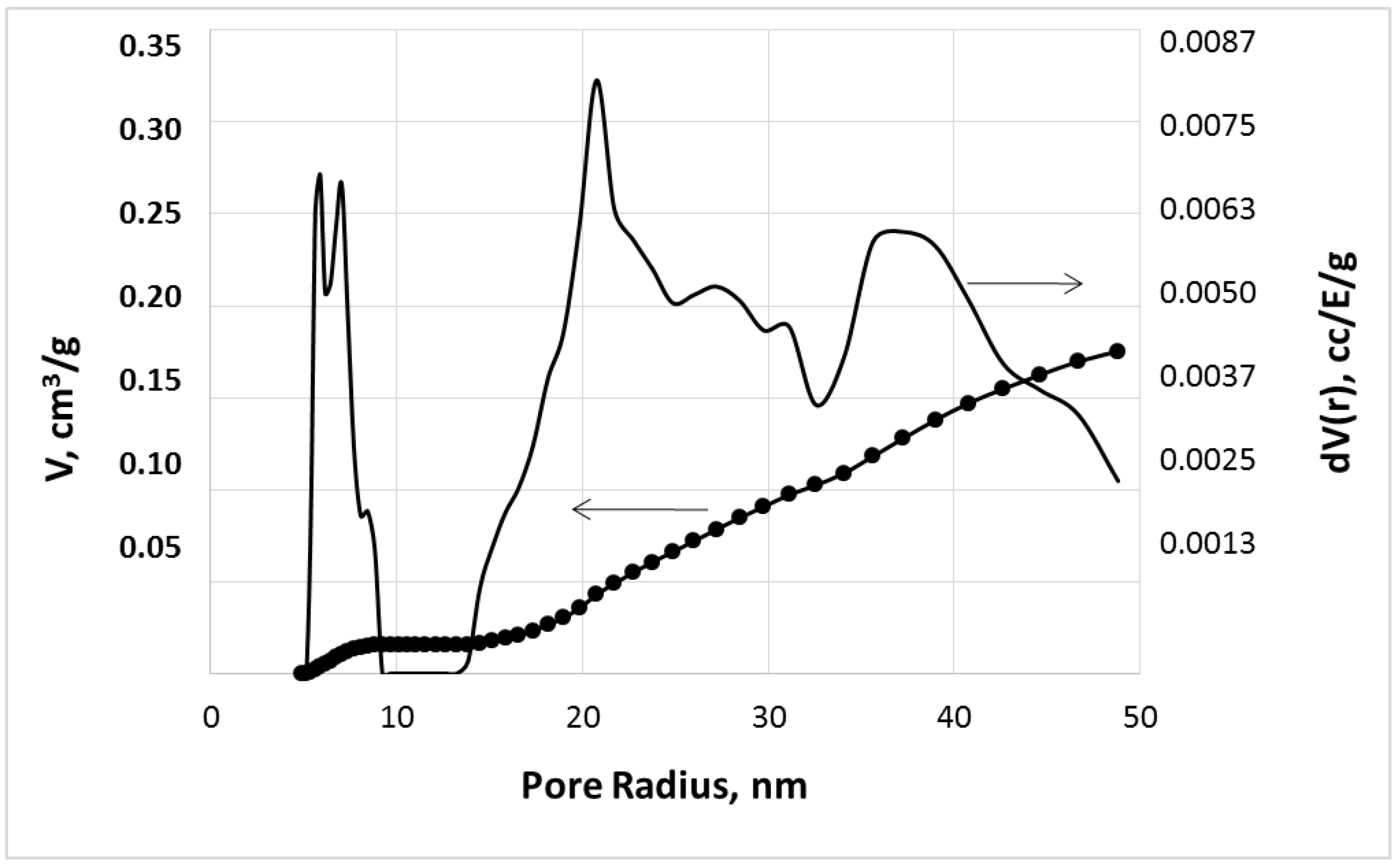
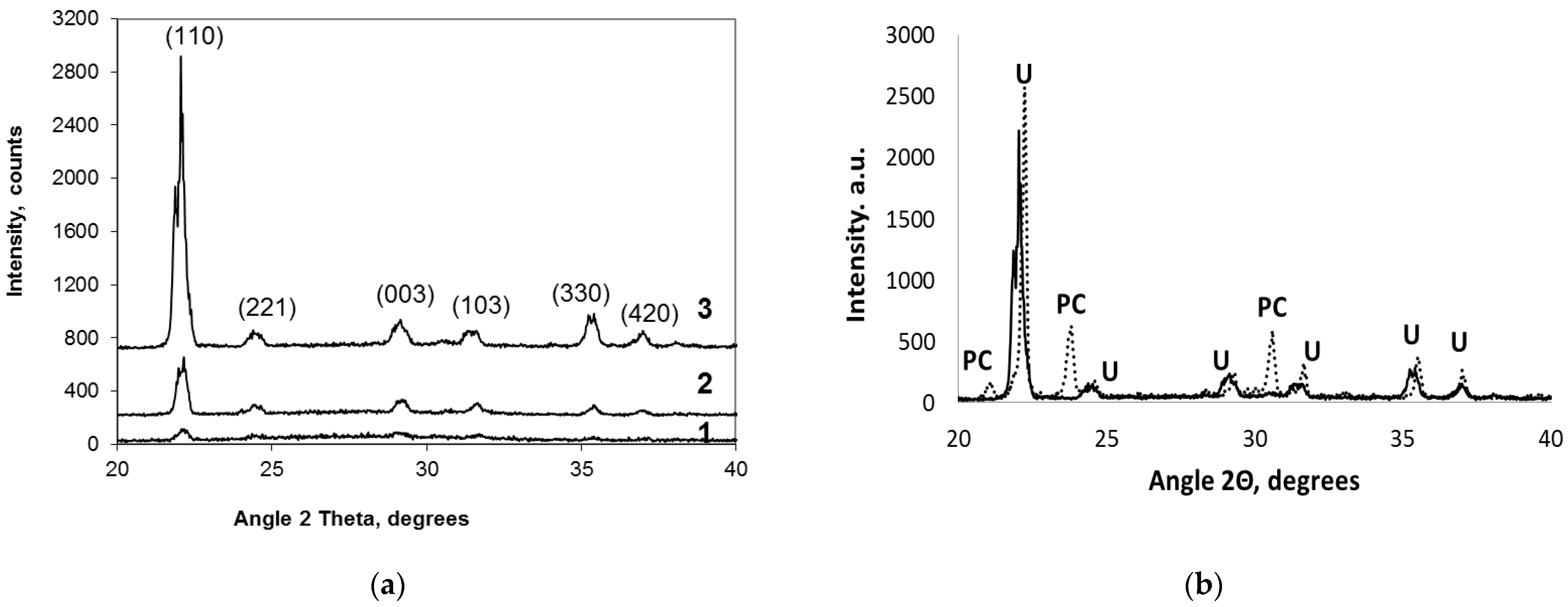


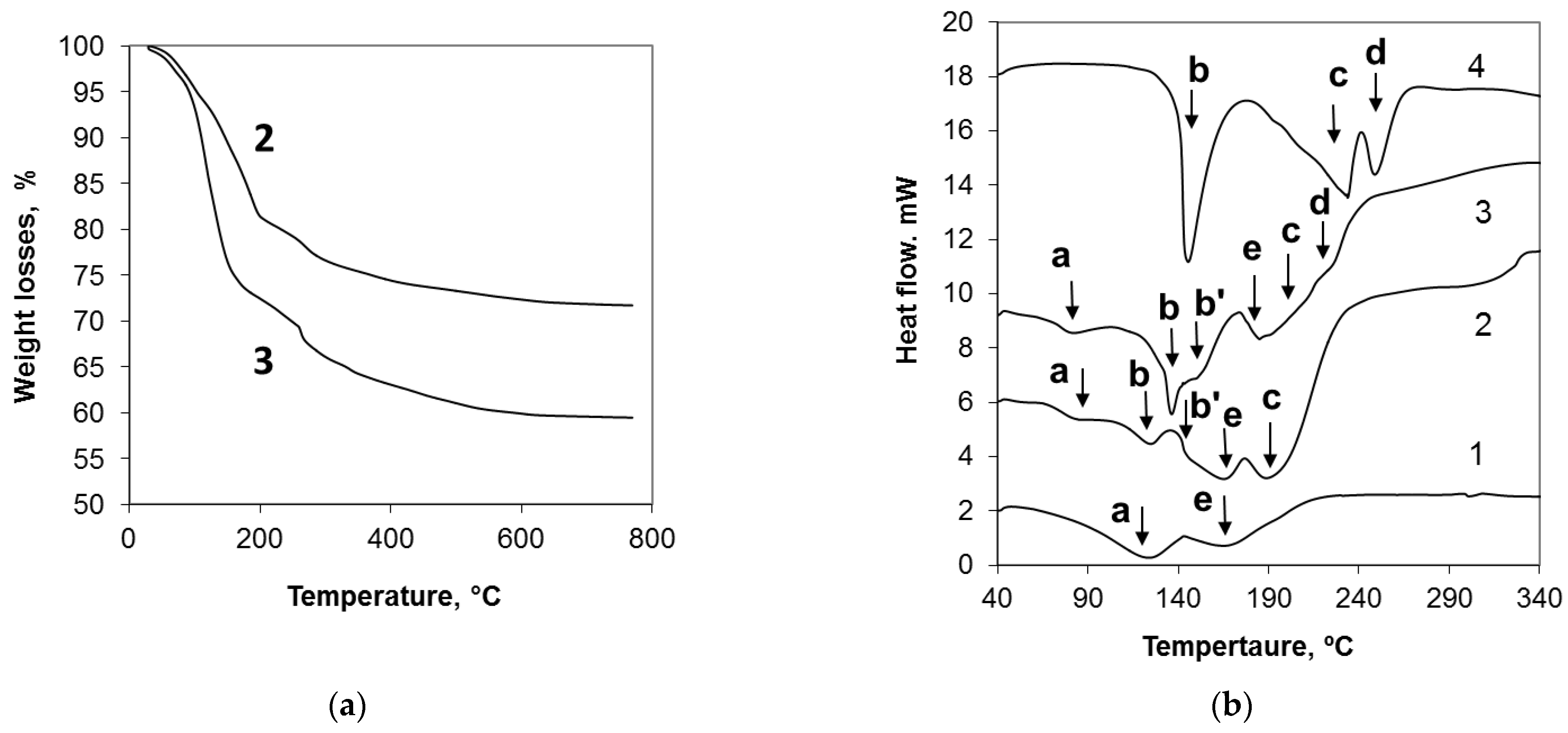
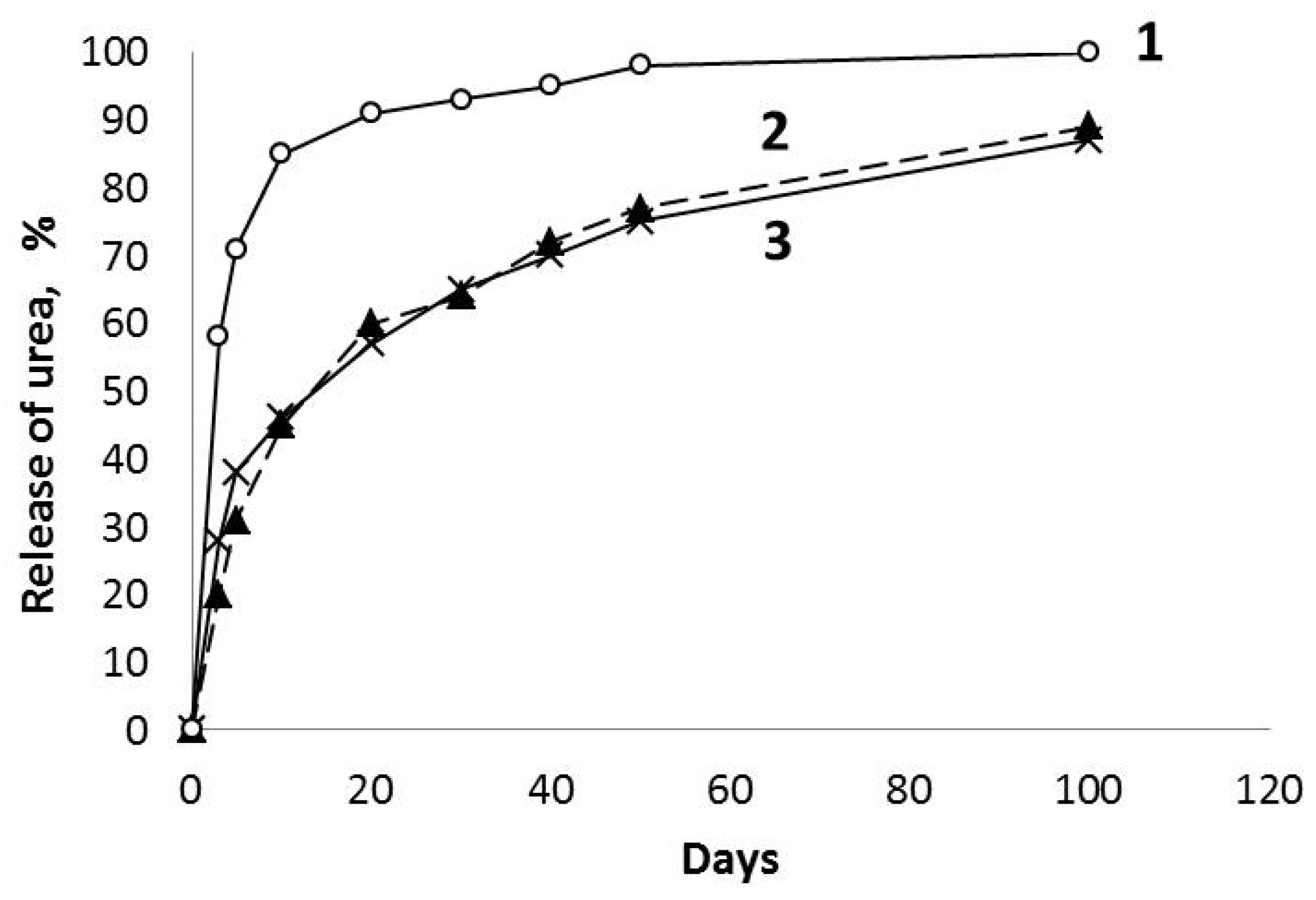
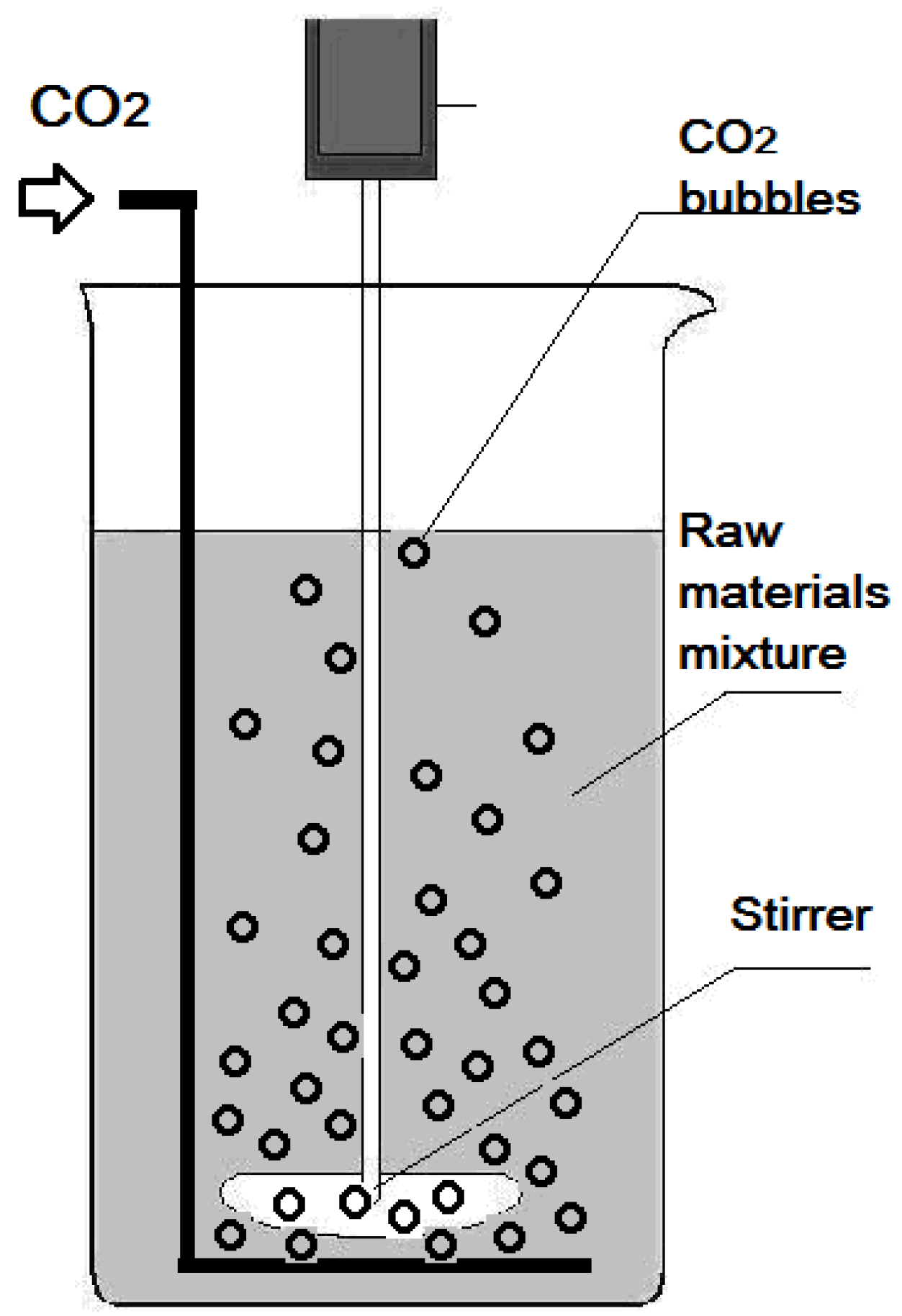
| No of the Gel | Admixture of Urea to 100 mL of PSLG, g | Contents of the Components, wt.% | Density, g/cm3 | Specific Surface Area, m2/g | Porosity, % | ||
|---|---|---|---|---|---|---|---|
| K2O·3.1SiO2 | Urea | H2O | |||||
| 1 | 10 | 83.8 | 5.8 | 10.4 | 1.19 ± 0.01 | 158 | 20.6 |
| 2 | 20 | 75.2 | 12.6 | 12.2 | 1.17 ± 0.02 | 145 | 18.7 |
| 3 | 30 | 63.8 | 17.9 | 18.3 | 1.14 ± 0.02 | 139 | 17.9 |
Disclaimer/Publisher’s Note: The statements, opinions and data contained in all publications are solely those of the individual author(s) and contributor(s) and not of MDPI and/or the editor(s). MDPI and/or the editor(s) disclaim responsibility for any injury to people or property resulting from any ideas, methods, instructions or products referred to in the content. |
© 2023 by the authors. Licensee MDPI, Basel, Switzerland. This article is an open access article distributed under the terms and conditions of the Creative Commons Attribution (CC BY) license (https://creativecommons.org/licenses/by/4.0/).
Share and Cite
Gorokhovsky, A.; Burmistrov, I.; Kuznetsov, D.; Gusev, A.; Khaidarov, B.; Kiselev, N.; Boychenko, E.; Kolesnikov, E.; Prokopovich, K.; Konyukhov, Y.; et al. Structure and Properties of the Xerogels Based on Potassium Silicate Liquid Glass and Urea. Molecules 2023, 28, 5466. https://doi.org/10.3390/molecules28145466
Gorokhovsky A, Burmistrov I, Kuznetsov D, Gusev A, Khaidarov B, Kiselev N, Boychenko E, Kolesnikov E, Prokopovich K, Konyukhov Y, et al. Structure and Properties of the Xerogels Based on Potassium Silicate Liquid Glass and Urea. Molecules. 2023; 28(14):5466. https://doi.org/10.3390/molecules28145466
Chicago/Turabian StyleGorokhovsky, Alexander, Igor Burmistrov, Denis Kuznetsov, Alexander Gusev, Bekzod Khaidarov, Nikolay Kiselev, Elena Boychenko, Evgeny Kolesnikov, Ksenia Prokopovich, Yuri Konyukhov, and et al. 2023. "Structure and Properties of the Xerogels Based on Potassium Silicate Liquid Glass and Urea" Molecules 28, no. 14: 5466. https://doi.org/10.3390/molecules28145466








